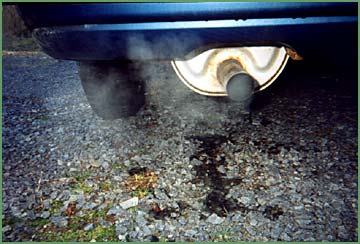No More Hot Air
by Murray MacAdam

Global warming got a group of university students hot-under-the-collar. But instead of just steaming at the government, they did something about it. |
It was a strange sight on the smoggy streets of Toronto: an eye-catching red bus running on clean (or at least cleaner) burning vegetable oil, escorted by a "critical mass" of local cyclists.
Inside the bus, students from New Brunswick's Mount Allison University worked at computers powered by solar panels mounted on the vehicle's roof.
The Climate Change Caravan had rolled into town.
It was the latest stop in a cross-country mission to educate Canadians about global warming. Along the way the students spoke to dozens of community groups and grabbed media headlines.
They inspired hundreds of Canadians to commit to lifestyle changes to reduce carbon emissions through their website - thebet.ca.
And they walked - and biked - their talk. The students pedalled across Canada, from Tofino to St. John's, with the eco-bus in their wake. The caravan ended in Halifax earlier in the fall.
The feisty band of students, some giving up a summer's earnings towards university tuition, launched the Climate Change Caravan because most of the news on global warming is still bleak as we keep hearing - and seeing for ourselves - how it's getting hotter and hotter.

They want people to take down-to-earth actions to reduce global warming. Biking or walking to work, using a clothesline and turning down the thermostat are among the steps to reducing carbon emissions suggested on their website.
An on-line calculator tallies the emissions saved by each person who signs up.
"With your help we can succeed where the government has failed, reducing household emissions by 50 percent," the Caravan team dream out loud on the web.
"This project is about getting every single Canadian to take on climate change and to make changes in their lives to stop this problem," says Caravan organizer Kate Kennedy.
The students hammered home a key point: each of us can actually do something. Thirty percent of Canada's total greenhouse gas emissions arise from individuals, through the cars we drive, the homes we heat and the appliances we turn on.

The Climate Change Caravan grew out of frustration with Canada's wimpy stance at the climate change negotiations at The Hague in late 2000.
Negotiations at that UN Climate Summit, struck to finalize the 1997 Kyoto Protocol, broke down when the European Union was unable to overcome the positions of the major polluting nations, such as the U.S., Japan and yes, Canada.
The Kyoto Protocol was finally ratified (without the U.S.) in Germany in July of this year. But under the agreement, Canada committed to reducing its greenhouse gas emissions to only 6 percent below 1990 levels by 2012, even though our per capita energy use is one of the world's highest.
Canada's emissions are estimated to be about 20 percent above our Kyoto commitment. And that will rise if Ottawa raises oil and gas production to meet mounting U.S. demands.
So much for our pristine image.
Hence the Caravan. "We're not giving up on government, but we can't keep looking to our leaders to provide leadership if the public is not behind it," says Kennedy. "Every Canadian has to be working on this issue for government to respond."
The hope is that once a good number of Canadians show they're willing to change their lifestyles, government will have to match those efforts.
Information is of course the first step. Remarkably, many Canadians remain ignorant about the causes of global warming. Less than one in five Canadians are likely to identify greenhouse gas emissions from fossil fuels as the major cause of global warming, according to a poll by Environics Canada.
But the Climate Change Caravan is just one example of a hopeful trend of moving from awareness to action.
How to Cool It
Many different players, from individuals to businesses to non-profit groups, are trying to lighten our demands on the planet. Even governments. Environment Canada's climate change website is a good place to start for info on global warming and what you and the government can do about it.
And there are many other initiatives that can help prevent good intentions from going up in smoke.
Alberta may not be the first Canadian province to come to mind as a bastion of enlightened environmental practice, but it is home to the Pembina Institute for Appropriate Development. Pembina has developed a site called Climate Change Solutions loaded with ideas to help people, organizations and industries reduce greenhouse gas emissions.
Teaching About Climate Change is an 80-page guide from Toronto-based Green Teacher magazine, chockfull of ideas to make global warming real for students, including hands-on explorations of energy and transportation alternatives.
A good source of solutions is Guy Dauncey's new book Stormy Weather: 101 Solutions to Global Climate Change which outlines how we can cut our use of fossil fuels and turn to solar, wind and other clean sources for energy. It is available from New Society book publishers.
The World Resource Institute's global warming website Safe Climate helps you calculate your personal or organizational "carbon footprint," then take action to reduce it. Other pages on this U.S. site include success stories of individuals and organizations that have changed their habits to preserve the planet.
The site of well-known Canadian environmentalist David Suzuki has lots of basic info on global warming along with prescriptions on how we can turn down the heat.
Suzuki's site serves up the usual unhappy news drawn from the big bad world of business. Industry produces over 35 percent of Canada's total greenhouse gases, with a handful of industries the main culprits, including - you guessed it - the oil and gas industry.
But business is actually doing better than you might think in cleaning up its act. Canada's pulp and paper industry cut its greenhouse gas emissions by 12 percent between 1990 and 1997, while hiking production 21 percent.
The aluminium industry slashed its emissions by 41 percent per unit of production between 1990 and 1998 while production rose 51 percent.
And if you think wind and solar power are good ideas but utopian pipedreams, think again. On a holiday in Britain the most memorable sight I saw was not an ancient castle or mountain peak but something far more modern. Several times our car came over the crest of a hill to see a field of majestic turbines, spinning in the wind.

Wind power is booming in Europe: capacity soared 32 percent in 2000 from 13,455 megawatts to 17,700. We're lagging behind, but won't be if the Canadian Wind Energy Association and others have their way. The CWEA is pushing for measures that ensure at least 5 percent of our electricity comes from this clean energy source by 2010.
"If we just do what makes economic sense, we will also end up solving the climate problem," argues Amory Lovins, well-known environmentalist and one of the authors of Natural Capitalism.
But there's another big player - government - that can tilt the economy and individuals toward windmills and blue skies.
After all, it was Canada's government and those of 177 nations around the world that finally agreed on the Kyoto Protocol on Climate Change in Germany. Many argue the agreement doesn't go far enough, but it did give the climate protection movement a badly needed shot in the arm.
(To keep up on international climate change negotiations, check out the Winnipeg-based International Institute for Sustainable Development.)
Another heartening move by governments occurred a month later. Leaders of the five eastern provinces and six New England states agreed to reduce their greenhouse gas emissions deeper than that required by Kyoto - to 1990 levels by 2010 with a further 10 percent cut by 2020.
A recent development underscores how we have to keep up the heat on government. The Chretien Government is considering a bold $2-billion proposal to get one million trucks off Ontario's busy highway 401 traffic corridor and onto railway cars instead.
But it would require $2-billion in new and upgraded rail lines, would anger truckers, and runs up against the Ontario Government, which claims that that Ottawa's plan makes no sense.
On this issue and many others, political leadership is needed, not just blind trust in the magic of the marketplace. But the government can't act without public pressure pushing it on.
What about the rest of the world? The U.S. backed out of Kyoto in part arguing that it could not agree to cut its own greenhouse gas emissions if those from India and China, home to over 2 billion people, were exempt.
There is a kernel of truth to this argument. In Shanghai, greenhouse gas emissions are predicted to soar sevenfold by 2020.
Yet a recent National Resources Defence Council report says China is moving quickly to slash its carbon dioxide emissions, the main culprit in global warming. Levels have plunged 17 percent since 1997, despite economic growth of 36 percent.
China achieved this remarkable feat through better energy efficiency and switching to cleaner energy sources. And this positive trend is accelerating. For example, China will shut down all of its dirtiest coal-fired plants over the next five years.
Of course, the only thing you and I have direct control over is our individual actions. So back home in my own backyard, I decided to join the Mount A students' climate-healing crusade at The Bet. One way I am cutting my energy use is by using an old-fashioned clothesline on my deck, instead of a drier.
I'll confess: it can be a pain in the ass to lug a load of wet clothes up three flights of stairs. But it sure beats more muggy 35-degree days in Toronto.
Murray MacAdam is a Toronto-based writer specialising in community development and global issues.
Written September 2001
| Return to Top
|
| Articles Archive
| About Our Times |